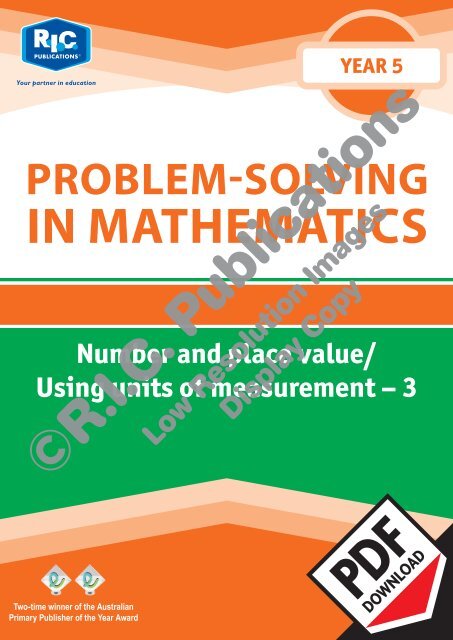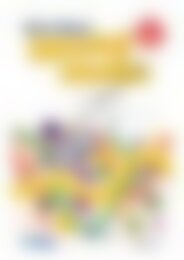20770_Problem_solving_Year_5_Number_and_place_value_Using_units_of_measurement_3
You also want an ePaper? Increase the reach of your titles
YUMPU automatically turns print PDFs into web optimized ePapers that Google loves.
Your partner in education<br />
YEAR 5<br />
PROBLEM-SOLVING<br />
IN MATHEMATICS<br />
<strong>Number</strong> <strong>and</strong> <strong>place</strong> <strong>value</strong>/<br />
<strong>Using</strong> <strong>units</strong> <strong>of</strong> <strong>measurement</strong> – 3<br />
Two-time winner <strong>of</strong> the Australian<br />
Primary Publisher <strong>of</strong> the <strong>Year</strong> Award
<strong>Problem</strong>-<strong>solving</strong> in mathematics<br />
(Book F)<br />
Published by R.I.C. Publications ® 2008<br />
Copyright © George Booker <strong>and</strong><br />
Denise Bond 2008<br />
RIC–<strong>20770</strong><br />
This master may only be reproduced by the<br />
original purchaser for use with their class(es). The<br />
publisher prohibits the loaning or onselling <strong>of</strong> this<br />
master for the purposes <strong>of</strong> reproduction.<br />
Copyright Notice<br />
Blackline masters or copy masters are published <strong>and</strong><br />
sold with a limited copyright. This copyright allows<br />
publishers to provide teachers <strong>and</strong> schools with a<br />
wide range <strong>of</strong> learning activities without copyright<br />
being breached. This limited copyright allows the<br />
purchaser to make sufficient copies for use within<br />
their own education institution. The copyright is not<br />
transferable, nor can it be onsold. Following these<br />
instructions is not essential but will ensure that you,<br />
as the purchaser, have evidence <strong>of</strong> legal ownership<br />
to the copyright if inspection occurs.<br />
For your added protection in the case <strong>of</strong> copyright<br />
inspection, please complete the form below. Retain<br />
this form, the complete original document <strong>and</strong> the<br />
invoice or receipt as pro<strong>of</strong> <strong>of</strong> purchase.<br />
Name <strong>of</strong> Purchaser:<br />
Date <strong>of</strong> Purchase:<br />
Supplier:<br />
School Order# (if applicable):<br />
Signature <strong>of</strong> Purchaser:<br />
Internet websites<br />
In some cases, websites or specific URLs may be recommended. While these are checked <strong>and</strong> rechecked at the time <strong>of</strong> publication,<br />
the publisher has no control over any subsequent changes which may be made to webpages. It is strongly recommended that the class<br />
teacher checks all URLs before allowing students to access them.<br />
View all pages online<br />
PO Box 332 Greenwood Western Australia 6924<br />
Website: www.ricpublications.com.au<br />
Email: mail@ricgroup.com.au
FOREWORD<br />
Books A–G <strong>of</strong> <strong>Problem</strong>-<strong>solving</strong> in mathematics have been developed to provide a rich resource for teachers<br />
<strong>of</strong> students from the early years to the end <strong>of</strong> middle school <strong>and</strong> into secondary school. The series <strong>of</strong> problems,<br />
discussions <strong>of</strong> ways to underst<strong>and</strong> what is being asked <strong>and</strong> means <strong>of</strong> obtaining solutions have been built up to<br />
improve the problem-<strong>solving</strong> performance <strong>and</strong> persistence <strong>of</strong> all students. It is a fundamental belief <strong>of</strong> the authors<br />
that it is critical that students <strong>and</strong> teachers engage with a few complex problems over an extended period rather than<br />
spend a short time on many straightforward ‘problems’ or exercises. In particular, it is essential to allow students<br />
time to review <strong>and</strong> discuss what is required in the problem-<strong>solving</strong> process before moving to another <strong>and</strong> different<br />
problem. This book includes extensive ideas for extending problems <strong>and</strong> solution strategies to assist teachers in<br />
implementing this vital aspect <strong>of</strong> mathematics in their classrooms. Also, the problems have been constructed <strong>and</strong><br />
selected over many years’ experience with students at all levels <strong>of</strong> mathematical talent <strong>and</strong> persistence, as well as<br />
in discussions with teachers in classrooms, pr<strong>of</strong>essional learning <strong>and</strong> university settings.<br />
<strong>Problem</strong>-<strong>solving</strong> does not come easily to most people,<br />
so learners need many experiences engaging with<br />
problems if they are to develop this crucial ability. As<br />
they grapple with problem, meaning <strong>and</strong> find solutions,<br />
students will learn a great deal about mathematics<br />
<strong>and</strong> mathematical reasoning; for instance, how to<br />
organise information to uncover meanings <strong>and</strong> allow<br />
connections among the various facets <strong>of</strong> a problem<br />
to become more apparent, leading to a focus on<br />
organising what needs to be done rather than simply<br />
looking to apply one or more strategies. In turn, this<br />
extended thinking will help students make informed<br />
choices about events that impact on their lives <strong>and</strong> to<br />
interpret <strong>and</strong> respond to the decisions made by others<br />
at school, in everyday life <strong>and</strong> in further study.<br />
Student <strong>and</strong> teacher pages<br />
The student pages present problems chosen with a<br />
particular problem-<strong>solving</strong> focus <strong>and</strong> draw on a range<br />
<strong>of</strong> mathematical underst<strong>and</strong>ings <strong>and</strong> processes.<br />
For each set <strong>of</strong> related problems, teacher notes <strong>and</strong><br />
discussion are provided, as well as indications <strong>of</strong><br />
how particular problems can be examined <strong>and</strong> solved.<br />
Answers to the more straightforward problems <strong>and</strong><br />
detailed solutions to the more complex problems<br />
ensure appropriate explanations, the use <strong>of</strong> the<br />
pages, foster discussion among students <strong>and</strong> suggest<br />
ways in which problems can be extended. Related<br />
problems occur on one or more pages that extend the<br />
problem’s ideas, the solution processes <strong>and</strong> students’<br />
underst<strong>and</strong>ing <strong>of</strong> the range <strong>of</strong> ways to come to terms<br />
with what problems are asking.<br />
At the top <strong>of</strong> each teacher page, there is a statement<br />
that highlights the particular thinking that the<br />
problems will dem<strong>and</strong>, together with an indication<br />
<strong>of</strong> the mathematics that might be needed <strong>and</strong> a list<br />
<strong>of</strong> materials that could be used in seeking a solution.<br />
A particular focus for the page or set <strong>of</strong> three pages<br />
<strong>of</strong> problems then exp<strong>and</strong>s on these aspects. Each<br />
book is organised so that when a problem requires<br />
complicated strategic thinking, two or three problems<br />
occur on one page (supported by a teacher page with<br />
detailed discussion) to encourage students to find<br />
a solution together with a range <strong>of</strong> means that can<br />
be followed. More <strong>of</strong>ten, problems are grouped as a<br />
series <strong>of</strong> three interrelated pages where the level <strong>of</strong><br />
complexity gradually increases, while the associated<br />
teacher page examines one or two <strong>of</strong> the problems in<br />
depth <strong>and</strong> highlights how the other problems might be<br />
solved in a similar manner.<br />
R.I.C. Publications ® www.ricpublications.com.au <strong>Problem</strong>-<strong>solving</strong> in mathematics<br />
iii
FOREWORD<br />
Each teacher page concludes with two further aspects<br />
critical to successful teaching <strong>of</strong> problem-<strong>solving</strong>. A<br />
section on likely difficulties points to reasoning <strong>and</strong><br />
content inadequacies that experience has shown may<br />
well impede students’ success. In this way, teachers<br />
can be on the look out for difficulties <strong>and</strong> be prepared<br />
to guide students past these potential pitfalls. The<br />
final section suggests extensions to the problems to<br />
enable teachers to provide several related experiences<br />
with problems <strong>of</strong> these kinds in order to build a rich<br />
array <strong>of</strong> experiences with particular solution methods;<br />
for example, the numbers, shapes or <strong>measurement</strong>s<br />
in the original problems might change but leave the<br />
means to a solution essentially the same, or the<br />
context may change while the numbers, shapes or<br />
<strong>measurement</strong>s remain the same. Then numbers,<br />
shapes or <strong>measurement</strong>s <strong>and</strong> the context could be<br />
changed to see how the students h<strong>and</strong>le situations<br />
that appear different but are essentially the same<br />
as those already met <strong>and</strong> solved. Other suggestions<br />
ask students to make <strong>and</strong> pose their own problems,<br />
investigate <strong>and</strong> present background to the problems<br />
or topics to the class, or consider solutions at a more<br />
general level (possibly involving verbal descriptions<br />
<strong>and</strong> eventually pictorial or symbolic arguments).<br />
In this way, not only are students’ ways <strong>of</strong> thinking<br />
extended but the problems written on one page are<br />
used to produce several more problems that utilise<br />
the same approach.<br />
Mathematics <strong>and</strong> language<br />
The difficulty <strong>of</strong> the mathematics gradually increases<br />
over the series, largely in line with what is taught<br />
at the various year levels, although problem-<strong>solving</strong><br />
both challenges at the point <strong>of</strong> the mathematics<br />
that is being learned as well as provides insights<br />
<strong>and</strong> motivation for what might be learned next. For<br />
example, the computation required gradually builds<br />
from additive thinking, using addition <strong>and</strong> subtraction<br />
separately <strong>and</strong> together, to multiplicative thinking,<br />
where multiplication <strong>and</strong> division are connected<br />
conceptions. More complex interactions <strong>of</strong> these<br />
operations build up over the series as the operations<br />
are used to both come to terms with problems’<br />
meanings <strong>and</strong> to achieve solutions. Similarly, twodimensional<br />
geometry is used at first but extended<br />
to more complex uses over the range <strong>of</strong> problems,<br />
then joined by interaction with three-dimensional<br />
ideas. Measurement, including chance <strong>and</strong> data, also<br />
extends over the series from length to perimeter, <strong>and</strong><br />
from area to surface area <strong>and</strong> volume, drawing on<br />
the relationships among these concepts to organise<br />
solutions as well as giving an underst<strong>and</strong>ing <strong>of</strong> the<br />
metric system. Time concepts range from interpreting<br />
timetables using 12-hour <strong>and</strong> 24-hour clocks while<br />
investigations related to mass rely on both the concept<br />
itself <strong>and</strong> practical <strong>measurement</strong>s.<br />
The language in which the problems are expressed is<br />
relatively straightforward, although this too increases<br />
in complexity <strong>and</strong> length <strong>of</strong> expression across the books<br />
in terms <strong>of</strong> both the context in which the problems<br />
are set <strong>and</strong> the mathematical content that is required.<br />
It will always be a challenge for some students<br />
to ‘unpack’ the meaning from a worded problem,<br />
particularly as problems’ context, information <strong>and</strong><br />
meanings exp<strong>and</strong>. This ability is fundamental to the<br />
nature <strong>of</strong> mathematical problem-<strong>solving</strong> <strong>and</strong> needs to<br />
be built up with time <strong>and</strong> experiences rather than be<br />
iv<br />
<strong>Problem</strong>-<strong>solving</strong> in mathematics www.ricpublications.com.au R.I.C. Publications ®
FOREWORD<br />
diminished or left out <strong>of</strong> the problems’ situations. One<br />
reason for the suggestion that students work in groups<br />
is to allow them to share <strong>and</strong> assist each other with<br />
the tasks <strong>of</strong> discerning meanings <strong>and</strong> ways to tackle<br />
the ideas in complex problems through discussion,<br />
rather than simply leaping into the first ideas that<br />
come to mind (leaving the full extent <strong>of</strong> the problem<br />
unrealised).<br />
An approach to <strong>solving</strong> problems<br />
Try<br />
an approach<br />
Explore<br />
means to a solution<br />
Analyse<br />
the problem<br />
The careful, gradual development <strong>of</strong> an ability to<br />
analyse problems for meaning, organising information<br />
to make it meaningful <strong>and</strong> to make the connections<br />
among them more meaningful in order to suggest<br />
a way forward to a solution is fundamental to the<br />
approach taken with this series, from the first book<br />
to the last. At first, materials are used explicitly to<br />
aid these meanings <strong>and</strong> connections; however, in<br />
time they give way to diagrams, tables <strong>and</strong> symbols<br />
as underst<strong>and</strong>ing <strong>and</strong> experience <strong>of</strong> <strong>solving</strong> complex,<br />
engaging problems increases. As the problem forms<br />
exp<strong>and</strong>, the range <strong>of</strong> methods to solve problems<br />
is carefully extended, not only to allow students to<br />
successfully solve the many types <strong>of</strong> problems, but<br />
also to give them a repertoire <strong>of</strong> solution processes<br />
that they can consider <strong>and</strong> draw on when new<br />
situations are encountered. In turn, this allows them<br />
to explore one or other <strong>of</strong> these approaches to see<br />
whether each might furnish a likely result. In this way,<br />
when they try a particular method to solve a new<br />
problem, experience <strong>and</strong> analysis <strong>of</strong> the particular<br />
situation assists them to develop a full solution.<br />
Not only is this model for the problem-<strong>solving</strong> process<br />
helpful in <strong>solving</strong> problems, it also provides a basis for<br />
students to discuss their progress <strong>and</strong> solutions <strong>and</strong><br />
determine whether or not they have fully answered<br />
a question. At the same time, it guides teacher<br />
questions <strong>of</strong> students <strong>and</strong> provides a means <strong>of</strong> seeing<br />
underlying mathematical difficulties <strong>and</strong> ways in<br />
which problems can be adapted to suit particular<br />
needs <strong>and</strong> extensions. Above all, it provides a common<br />
framework for discussions between a teacher <strong>and</strong><br />
group or whole class to focus on the problem-<strong>solving</strong><br />
process rather than simply on the solution <strong>of</strong> particular<br />
problems. Indeed, as Alan Schoenfeld, in Steen L (Ed)<br />
Mathematics <strong>and</strong> democracy (2001), states so well, in<br />
problem-<strong>solving</strong>:<br />
getting the answer is only the beginning rather than<br />
the end … an ability to communicate thinking is<br />
equally important.<br />
We wish all teachers <strong>and</strong> students who use these<br />
books success in fostering engagement with problem<strong>solving</strong><br />
<strong>and</strong> building a greater capacity to come to<br />
terms with <strong>and</strong> solve mathematical problems at all<br />
levels.<br />
George Booker <strong>and</strong> Denise Bond<br />
R.I.C. Publications ® www.ricpublications.com.au <strong>Problem</strong>-<strong>solving</strong> in mathematics<br />
v
CONTENTS<br />
Foreword .................................................................. iii – v<br />
Contents .......................................................................... vi<br />
Introduction ........................................................... vii – xix<br />
A note on calculator use ................................................ xx<br />
Teacher notes ................................................................. 2<br />
Coloured cubes .............................................................. 3<br />
Growing cubes ............................................................... 4<br />
Viewing cubes ................................................................ 5<br />
Teacher notes ................................................................. 6<br />
Market days ................................................................... 7<br />
Teacher notes ................................................................. 8<br />
Bookworms .................................................................... 9<br />
Calculator patterns ...................................................... 10<br />
Puzzle scrolls 1.............................................................. 11<br />
Teacher notes ............................................................... 12<br />
The seedling nursery .................................................... 13<br />
The tropical fruit orchard ............................................. 14<br />
Animal Safari Park ...................................................... 15<br />
Teacher notes ............................................................... 16<br />
Desert adventures ........................................................ 17<br />
Teacher notes ............................................................... 18<br />
Abstract art .................................................................. 19<br />
Time taken .................................................................... 20<br />
Puzzle scrolls 2.............................................................. 21<br />
Teacher notes ............................................................... 22<br />
The school’s records ..................................................... 23<br />
The town’s centenary ................................................... 24<br />
Keeping records ........................................................... 25<br />
Teacher notes ............................................................... 26<br />
<strong>Number</strong> patterns .......................................................... 27<br />
Teacher notes ............................................................... 28<br />
Magic squares ............................................................. 29<br />
Sudoku ......................................................................... 30<br />
Alphametic puzzles ...................................................... 31<br />
Teacher notes ............................................................... 32<br />
At the shops ................................................................. 33<br />
At the delicatessen ...................................................... 34<br />
The sugar mill .............................................................. 35<br />
Teacher notes ............................................................... 36<br />
The fish market ............................................................ 37<br />
Teacher notes ............................................................... 38<br />
Designing shapes ......................................................... 39<br />
Different designs ......................................................... 40<br />
<strong>Using</strong> designs ............................................................... 41<br />
Teacher notes ............................................................... 42<br />
How many? ................................................................... 43<br />
How far? ....................................................................... 44<br />
How much? ................................................................... 45<br />
Teacher notes ............................................................... 46<br />
Training runs ................................................................. 47<br />
Teacher notes ............................................................... 48<br />
Balancing business ...................................................... 49<br />
Calendar calculations .................................................. 50<br />
Puzzle scrolls 3.............................................................. 51<br />
Teacher notes ............................................................... 52<br />
Tall buildings ................................................................ 53<br />
Good sports .................................................................. 54<br />
Puzzle scrolls 4.............................................................. 55<br />
Teacher notes ............................................................... 56<br />
Tank water .................................................................... 57<br />
Square-deal nursery ..................................................... 58<br />
Salad days .................................................................... 59<br />
Teacher notes ............................................................... 60<br />
Shelley Beach .............................................................. 61<br />
Solutions .................................................................62–68<br />
Isometric resource page .............................................. 69<br />
0–99 board resource page ........................................... 70<br />
4-digit number exp<strong>and</strong>er resource page (x 5) ............. 71<br />
10 mm x 10 mm grid resource page ............................ 72<br />
15 mm x 15 mm grid resource page ............................ 73<br />
Triangular grid resource page ...................................... 74<br />
vi<br />
<strong>Problem</strong>-<strong>solving</strong> in mathematics www.ricpublications.com.au R.I.C. Publications ®
TEACHER NOTES<br />
<strong>Problem</strong>-<strong>solving</strong><br />
To use logical reasoning <strong>and</strong> an ability to visualise a<br />
sequence <strong>of</strong> events so as to then use number patterns to<br />
solve problems<br />
Materials<br />
calculator<br />
Focus<br />
This page explores problems that involve a large amount<br />
<strong>of</strong> data that needs both computation <strong>and</strong> patterning to<br />
determine solutions.<br />
Discussion<br />
Page 61<br />
These problems can be used to examine the ‘analyseexplore-try’<br />
model <strong>of</strong> problem-<strong>solving</strong> that has evolved over<br />
the varied number, spatial, <strong>measurement</strong> situations posed<br />
in this book. This is discussed in detail in the introduction<br />
pages (xiv – xvii). In this problem the information needs to<br />
be carefully analysed to determine the distance <strong>of</strong> each<br />
shell from the starting line, the number <strong>of</strong> shells that are<br />
set out for the race <strong>and</strong> the distance to run to pick up<br />
<strong>and</strong> return each shell to the bucket, being that only one<br />
shell can be collected at a time. Some students may use<br />
counters to represent the race <strong>and</strong> see what is happening.<br />
<strong>Using</strong> a diagram is another way:<br />
Another way is to look for a pattern:<br />
4, 4 (1 + 2), 4 (1 + 2), 4 (1 + 2 + 3), 4 (1 + 2 + 3 + 4), …<br />
The total must be 4 x the sum <strong>of</strong> all the numbers 1–50.<br />
This result can be found by using a very famous method<br />
supposedly first shown by a mathematician named Gauss<br />
when he was only a young boy.<br />
Sum wanted is 1 + 2 + 3 + 4 + 5 … + 50.<br />
This sum is also 50 + 49 + 48 + … + 1.<br />
Twice the sum must be 50 x 51, so the sum is half <strong>of</strong> 50 x<br />
51. ([50 x 51 = 2500] ÷ 2 = 1275)<br />
The winner must run 4 x 1275 = 5100 m.<br />
This thinking now has to be applied in reverse to the<br />
second problem. Since Jeff picked up 42 shells, the<br />
distance he ran must be 4 x sum to 42 (i.e. 4 x half 42 x<br />
43), which is 3612 metres; Jeff ran 3 km 612 m.<br />
Possible difficulties<br />
• Not underst<strong>and</strong>ing the way in which the shells are<br />
distributed from the starting line<br />
• Only using the distances to the shells<br />
• Not attempting a solution because <strong>of</strong> the complexity<br />
<strong>of</strong> the steps or calculations<br />
Extension<br />
• Use smaller or larger number <strong>of</strong> shells for the race<br />
<strong>and</strong> vary the distance between shells.<br />
• Ask students to research the mathematician Karl<br />
Gauss <strong>and</strong> find out more about his famous solution to<br />
the sum <strong>of</strong> the first 50 numbers.<br />
When the problem is understood, a table that keeps track<br />
<strong>of</strong> the distances to each shell <strong>and</strong> the cumulative distance<br />
covered would enable an answer to be obtained, or even<br />
allow students to see a pattern in the results that can be<br />
applied to the whole situation.<br />
Shell number Distance run Total distance (metres)<br />
1 4 4<br />
2 8 4 + 8<br />
3 12 4 + 8 + 12<br />
4 16 4 + 8 + 12 + 16<br />
5 20 4 + 8 + 12 + 16 + 20<br />
This would suggest that adding all the numbers using a<br />
calculator which would give the correct answer <strong>of</strong> 5100 m<br />
or more than 5 km (which at first seems surprising).<br />
60<br />
<strong>Problem</strong>-<strong>solving</strong> in mathematics www.ricpublications.com.au R.I.C. Publications ®
SHELLEY BEACH<br />
At the Shelly Beach New <strong>Year</strong> Carnival the painted shell competition was the most<br />
keenly contested. Each contestant had a line <strong>of</strong> shells <strong>place</strong>d in front <strong>of</strong> them. In each<br />
line, the shells were <strong>place</strong>d at 2 m intervals. Contestants had to run from a starting line<br />
2 m before the first shell <strong>and</strong> collect each shell. Shells could only be collected one at<br />
a time, with each shell <strong>place</strong>d in a bucket at the starting line before running to get the<br />
next one.<br />
1. The shells had to be collected in order <strong>of</strong> first, second, third <strong>and</strong> so on until the last<br />
shell, 100 m from the starting line, had been collected. The winner was the first person<br />
to <strong>place</strong> all <strong>of</strong> their shells in their bucket.<br />
How far did the winner have to run?<br />
2. When the winner had collected all <strong>of</strong> their shells, the competition was finished <strong>and</strong> the<br />
number <strong>of</strong> shells in each bucket was counted to see who filled the other <strong>place</strong>s. Jeff<br />
had 42 shells in his bucket.<br />
How far had he run?<br />
R.I.C. Publications ® www.ricpublications.com.au <strong>Problem</strong>-<strong>solving</strong> in mathematics<br />
61
SOLUTIONS<br />
Note: Many solutions are written statements rather than just numbers. This is to encourage teachers <strong>and</strong><br />
students to solve problems in this way.<br />
SHELLEY BEACH ....................................................... page 61<br />
1. There are 50 shells to collect:<br />
Shell<br />
number<br />
Distance<br />
run<br />
1 4 4<br />
2 8 4 + 8<br />
3 12 4 + 8 + 12<br />
Total distance (metres)<br />
4 16 4 + 8 + 12 + 16<br />
5 20 4 + 8 + 12 + 16 + 20<br />
Look for a pattern<br />
4<br />
4(1 + 2)<br />
4(1 + 2 + 3)<br />
4(1 + 2 + 3 + 4)<br />
4(1 + 2 + 3 + 4 + 5)<br />
50 100 4 + 8 + 12 + 16 + 20 + + 50<br />
4(1 + 2 + 3 + 4 + 5 ... + 50)<br />
This can be totalled on a calculator to give the answer <strong>of</strong><br />
5100 m or 5 km 100 m.<br />
Another way is to look for a pattern:<br />
4, 4 (1 + 2), 4(1 + 2 + 3), 4(1 + 2 + 3 + 4), ...<br />
The total must be 4 x the sum <strong>of</strong> all the numbers 1–50:<br />
Sum wanted is 1 + 2 + 3 + 4 + 5 ... + 50<br />
This sum is also 50 + 49 + 48 + ... + 1<br />
Adding these two expressions <strong>of</strong> the distance shows that<br />
twice the sum must be 50 x 51<br />
The sum is half 50 x 51<br />
4 x half 50 x 51 is 5100<br />
The winner ran 5100 m or 5 km 100 m<br />
2. Jeff picked up 42 shells<br />
Distance he ran is 4 x sum to 42<br />
4 x half 42 x 432 is 3612<br />
Jeff ran 3612 m or 3 km 612 m<br />
68<br />
<strong>Problem</strong>-<strong>solving</strong> in mathematics www.ricpublications.com.au R.I.C. Publications ®


















